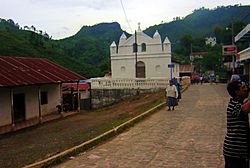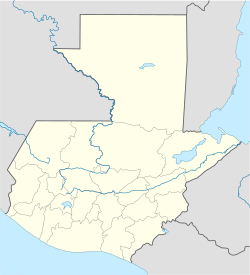San Agustín Lanquín facts for kids
Quick facts for kids
San Agustín Lanquín
|
|
|---|---|
|
Municipality of Guatemala
|
|

Catholic Church of Lanquín
|
|
| Country | |
| Department | |
| Municipality | Lanquín |
| Founded | 1540 |
| Government | |
| • Type | Municipal |
| Area | |
| • Total | 208 km2 (80 sq mi) |
| Elevation | 380 m (1,250 ft) |
| Population
(Census 2002)
|
|
| • Total | 16,546 |
| • Ethnicities | Q'eqchi' (95%) Ladino (5%) |
| • Religions | Roman Catholicism Evangelicalism Maya |
| Climate | Af |
| Website | www.inforpressca.com/lanquin |
San Agustín Lanquín, often called just Lanquín, is a town in Guatemala. It is part of the Alta Verapaz Department. The town sits about 380 meters (1,250 feet) above the sea level. Around 16,500 people live here. Most of them are from the Q'eqchi' Maya group. Lanquín covers an area of 208 square kilometers.
Contents
History of Lanquín
Early Settlement by Priests
Lanquín was settled peacefully in 1540. This was done by a group of priests called the Order of Preachers. Some of these priests were Pedro de Angulo, Luis de Cáncer, and Rodrigo de la Cebra. In the 1540s, the first Catholic church was built. It was named "San Agustín Lanquín."
Records show that Lanquín became a municipality in 1846. A municipality is like a local government area. Its first mayor was Crisanto Beb, a respected local leader.
Lanquín in the 20th Century
Lua error in Module:Location_map at line 420: attempt to index field 'wikibase' (a nil value). In May 1956, the government made Lanquín a National Park. This was because of its amazing natural beauty. It quickly became a popular place for tourists in Guatemala. Later, in 1970, Lanquín was named a National Monument. Then, in 1997, it was declared a National Cultural Heritage site. This means it is a very important part of Guatemala's culture.
In the 1960s, the area was important for raising animals and cutting down valuable wood. Companies also explored for old ruins. A big company from California invested a lot of money. They wanted to develop the southern Petén and Alta Verapaz regions. They formed a company called North Impulsadora. New settlers were brought to these areas. These areas were part of the Franja Transversal del Norte (FTN).
In 1964, a government group called INTA defined the FTN area. It included parts of several departments like Huehuetenango and Alta Verapaz. Priests from the Maryknoll order helped bring settlers to these new areas.
The Northern Transversal Strip was officially created in 1970. This was done by a law to help farming in the area. It included Lanquín and many other towns.
Culture of Lanquín
The culture in Lanquín is very rich. It is shaped by the Q'eqchi' people's beliefs. They have a special way of looking at nature and the world. This view strongly influences the community.
The Q'eqchi' culture teaches great respect for nature. This includes all animals and plants. However, this old belief is now facing challenges from other cultures.
Trust is very important in the Q'eqchi' culture. It is more important than legal papers for business and other dealings. This is because the Q'eqchi' believe in taking responsibility. They also value being clean, on time, and respectful. These things build trust.
Religion in Lanquín
About 65% of the people in Lanquín are Roman Catholic. But, in the last twenty years, other Christian groups have grown in the area.
Many Q'eqchi' people still follow their old traditions. These traditions involve talking with nature and the cosmos. It is not known exactly how many people still practice these traditions. However, it seems the number is getting smaller. There are two known ancient altars in the municipality. One is in the Grutas (caves) and another at Semuc Champey. It is believed that older people know about more secret altars.
Main Celebration and Fair
In Guatemala, towns celebrate their annual fair. This fair is usually based on the Catholic saint honored on the town's founding day. These celebrations often have fireworks and traditional food. There are also games for children, Christian events, and popular dances.
In Lanquín, the annual fair is held from August 24 to 28. The main day is August 28. This is when the Catholic Church celebrates Saint Augustine.
Tourism in Lanquín
Lanquín is a great place for tourists. A large cave complex called Grutas de Lanquín is only one kilometer away. About 11 kilometers south of Lanquín is the Cahabon River. Here you can find the Semuc Champey natural monument. Lanquín is often where tourists start their trips to Semuc Champey.
Climate
Lanquín has a tropical rainforest climate. This means it is hot and rainy all year round.
| Climate data for Lanquín | |||||||||||||
|---|---|---|---|---|---|---|---|---|---|---|---|---|---|
| Month | Jan | Feb | Mar | Apr | May | Jun | Jul | Aug | Sep | Oct | Nov | Dec | Year |
| Mean daily maximum °C (°F) | 27.5 (81.5) |
29.4 (84.9) |
30.7 (87.3) |
32.3 (90.1) |
32.1 (89.8) |
31.8 (89.2) |
30.6 (87.1) |
31.0 (87.8) |
30.9 (87.6) |
30.1 (86.2) |
28.7 (83.7) |
27.7 (81.9) |
30.2 (86.4) |
| Daily mean °C (°F) | 23.2 (73.8) |
24.1 (75.4) |
25.4 (77.7) |
26.8 (80.2) |
27.1 (80.8) |
27.1 (80.8) |
26.5 (79.7) |
26.6 (79.9) |
26.5 (79.7) |
25.9 (78.6) |
24.6 (76.3) |
23.3 (73.9) |
25.6 (78.1) |
| Mean daily minimum °C (°F) | 18.9 (66.0) |
18.8 (65.8) |
20.2 (68.4) |
21.3 (70.3) |
22.1 (71.8) |
22.5 (72.5) |
22.4 (72.3) |
22.2 (72.0) |
22.1 (71.8) |
21.7 (71.1) |
20.5 (68.9) |
19.0 (66.2) |
21.0 (69.8) |
| Average precipitation mm (inches) | 140 (5.5) |
85 (3.3) |
83 (3.3) |
104 (4.1) |
186 (7.3) |
419 (16.5) |
439 (17.3) |
331 (13.0) |
383 (15.1) |
336 (13.2) |
216 (8.5) |
149 (5.9) |
2,871 (113) |
| Source: Climate-Data.org | |||||||||||||
Geographic Location
 |
San Pedro Carchá, municipality of Alta Verapaz Department | San Pedro Carchá, municipality of Alta Verapaz Department |  |
|
| San Pedro Carchá, municipality of Alta Verapaz Department | Cahabón, municipality of Alta Verapaz Department | |||
| San Pedro Carchá, municipality of Alta Verapaz Department | San Pedro Carchá y Senahú, municipalities of Alta Verapaz Department | Senahú, municipality of Alta Verapaz Department |
Images for kids
See also
 In Spanish: Lanquín para niños
In Spanish: Lanquín para niños




